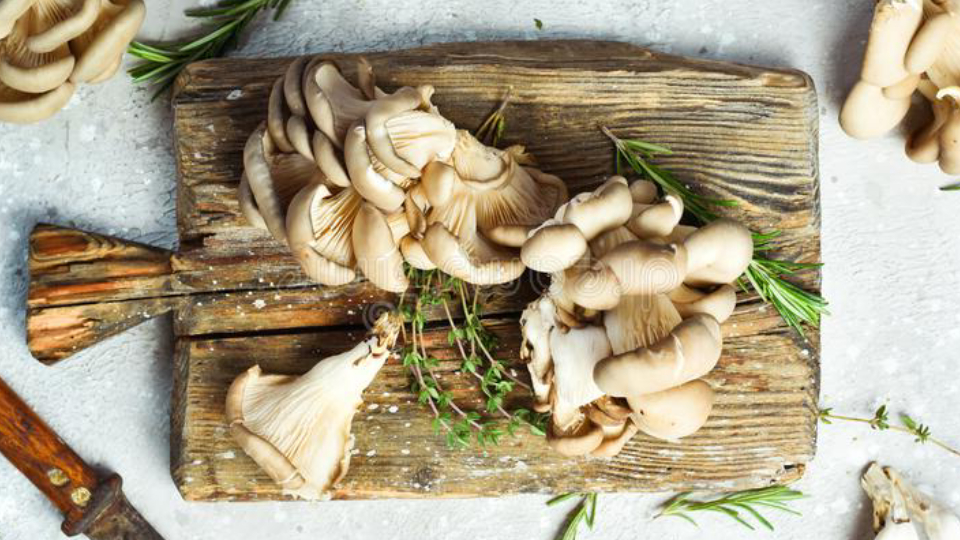How to Cook Maitake Mushrooms (Recipes)
Cooking maitake mushrooms is a delightful and nutritious way to savor their distinct flavor. These mushrooms can enhance a variety of dishes, including stir-fries, soups, and Pizzas. With their rich, earthy taste and meaty texture, they offer versatility and depth to any culinary creation.
So, if you haven’t tried maitake before, now is the perfect time to experiment with them. When cooked correctly, they emit an earthy, peppery flavor that can be balanced out with savory and salty ingredients. Additionally, these mushrooms are highly regarded for their distinct flavor and texture.
In this article:
What Do Maitake Mushrooms Taste Like?
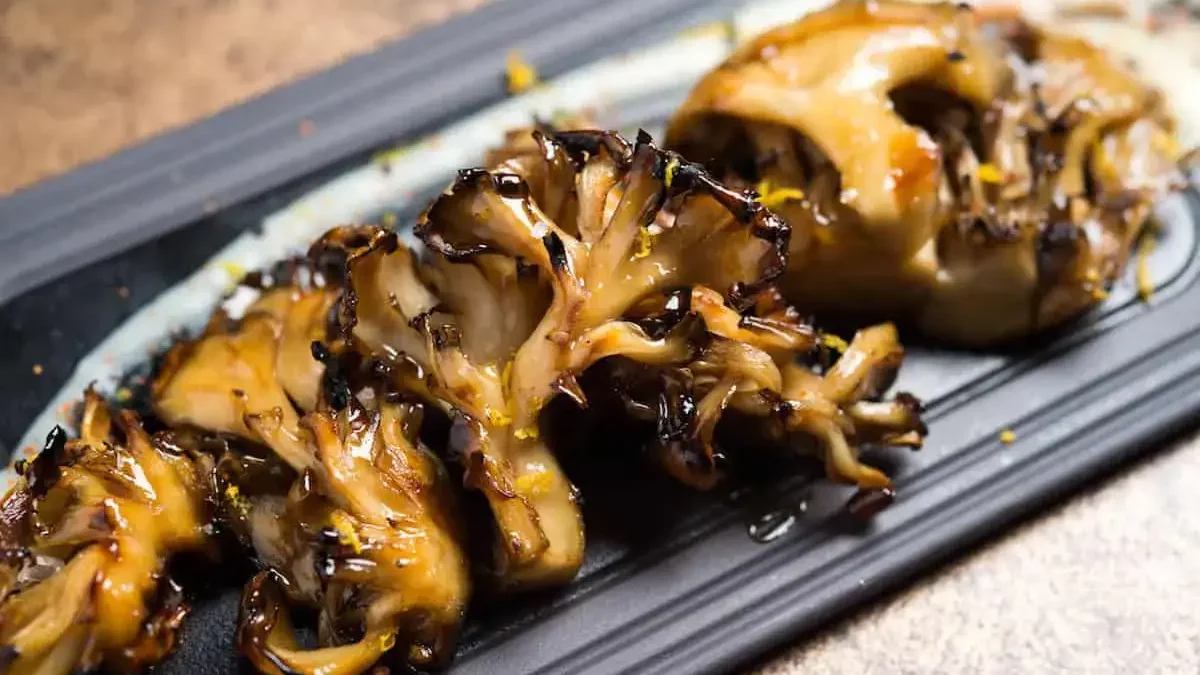
Maitake offers a distinctive taste and texture. Specifically, they have a savory, earthy flavor with a meaty texture and mild sweetness, often accompanied by a nutty undertone. While some individuals may detect a slight spiciness, this is not typical.
The mushroom’s woody or earthy aroma is likely the source of the “woodsy” description. However, the taste and smell can vary depending on the cooking method and other ingredients used in a dish.
How to Prepare Maitake Mushrooms
Preparing maitake mushrooms is easy with these simple steps:
- Cleaning – Maitake mushrooms can be quite dirty, so clean them thoroughly by wiping off dirt or debris with a damp paper towel or soft-bristled brush. You can also rinse them quickly under running water, but make sure to dry them thoroughly with a paper towel or kitchen towel.
- Cutting – Maitake mushrooms are large, so cut them into smaller pieces for even cooking. You can remove the stem and slice the mushrooms into bite-sized pieces using a sharp knife. Alternatively, tear them apart by hand.
- Stem Removal – Remove the stems of maitake mushrooms before cooking as they can be tough and fibrous. Simply grasp the stem and gently pull it away from the mushroom cap.
- Other Tips – Maitake mushrooms have a delicate flavor, so pair them with simple seasonings that enhance their natural taste. Garlic, thyme, rosemary, soy sauce, miso, and butter are popular flavor pairings. Use maitake mushrooms in a variety of dishes as they are a tasty and nutritious ingredient.
Ways to Cook Maitake Mushrooms
There are many different ways to serve maitake mushrooms, from sautéing to grilling to roasting.
8 Ways of Cooking Maitake Mushrooms
1. Grilled/Roasted:
Grilled maitake mushrooms are a delicious and healthy addition to any BBQ. Simply brush the mushrooms with some olive oil, sprinkle with salt and pepper, and grill over medium-high heat until they are tender and slightly charred.
2. Salads
They are a great addition to salads. Simply slice the mushrooms and toss them with your favorite greens, vegetables, and dressing.
3. Sauté
They can be sautéed with garlic, shallots, and herbs for a flavorful side dish.
4. Soups
You can also add them to soups and stews. Simply add the mushrooms to the pot and let them simmer until they are tender and flavorful.
5. Pasta Dishes
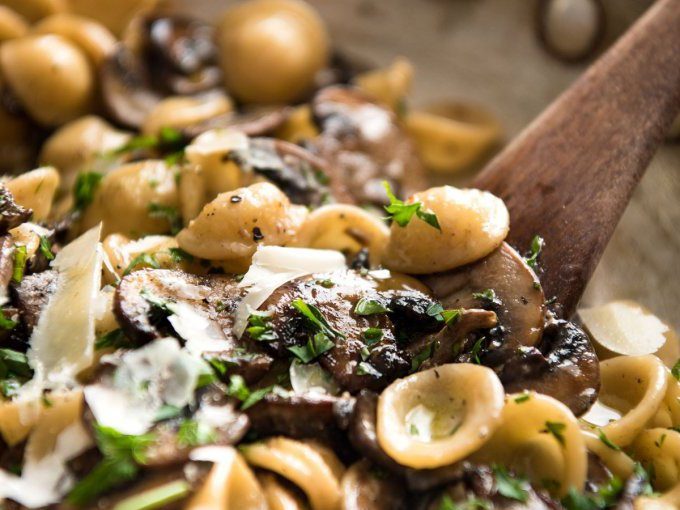
Pasta dishes are another option. Simply sauté the mushrooms with garlic and herbs, and toss with your favorite pasta and sauce.
6. Pizza
Top your favorite pizza dough with sautéed maitake mushrooms, cheese, and other toppings.
7. Mushroom Steak
My favorite one is Maitake mushroom steak. Simply season the mushrooms with salt, pepper, and your favorite spices, and grill or sauté until they are tender and flavorful.
8. Stir-Fry/Pan-Fry
Another popular option is adding maitake to stir-fries/pan-fries. Simply heat up some oil in a pan, add the sliced mushrooms, and cook until they are golden brown and crispy.
“Roasting, sautéing or grilling maitake mushrooms will help to concentrate the flavors and bring out their natural umami taste.”
– Paul Stamets, a well know mycogolist
Tips for Cooking Maitake
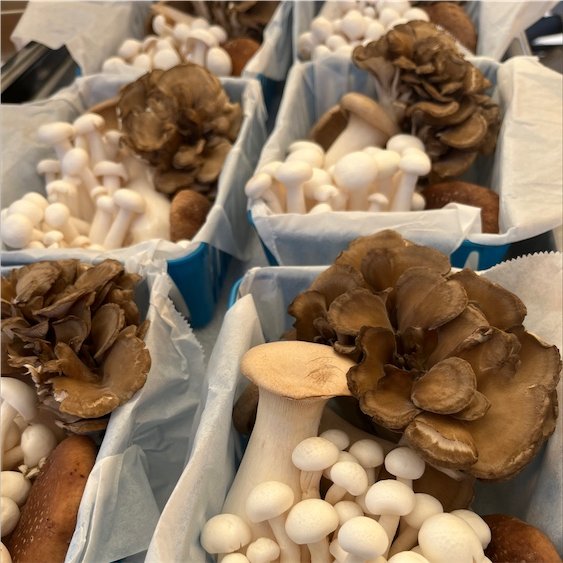
- Get fresh mushrooms – Use fresh mushrooms for the best flavor and texture. Look for firm mushrooms without any browning or decay.
- Prepare maitake mushrooms – To prepare the mushrooms, gently wipe them with a damp paper towel, remove any tough stems, and slice them into bite-sized pieces.
- Mixed with other fresh mushrooms – Mix maitake mushrooms with other fresh mushrooms like shiitake or portobello, adding more flavor and texture to dishes such as stir-fries or risottos.
- Mixed with herbs – Try mixing them with herbs like thyme or rosemary to enhance their flavor in roasted vegetables or soups.
Cooking Time for Maitake Mushrooms
The Table below outlines the cooking times and temperatures for different methods of cooking maitake mushrooms:
| Cooking Method | Temperature | Cooking Time |
| Roasting | 400°F (204°C) | 20-25 minutes |
| Boiling | Medium heat | 10-15 minutes |
| Sautéing | Medium-high heat | 5-7 minutes |
| Searing | High heat | 2-3 minutes |
| Grilling | Medium-high heat | 5-7 minutes per side |
| Pan-frying | Medium-high heat | 3-5 minutes per side |
Keep in mind that the cooking times mentioned above are approximate and may vary based on the size and thickness of the mushrooms. It’s important to monitor them closely during the cooking process and make adjustments as necessary.
How to Store Maitake Mushrooms
Before delving into how to cook maitake mushrooms, let’s discuss how to store and preserve maitake mushrooms.
6 Ways to Store Them
1. Refrigeration
To keep maitake mushrooms fresh for up to a week, store them in the vegetable compartment of your fridge in a paper bag or wrapped in a paper towel.
2. Freezing
For long-term storage, clean and cut the mushrooms into small pieces, blanch them in boiling water for 2-3 minutes, cool them in ice water, pat them dry, and store them in airtight freezer bags or containers. Frozen maitake mushrooms can last up to 6 months in the freezer.
3. Drying
To use dried maitake mushrooms in various recipes, clean and cut them into small pieces, spread them out on a baking sheet, dry them in an oven on the lowest setting or use a dehydrator, and store them in airtight containers in a cool, dry place.
4. Dehydrating
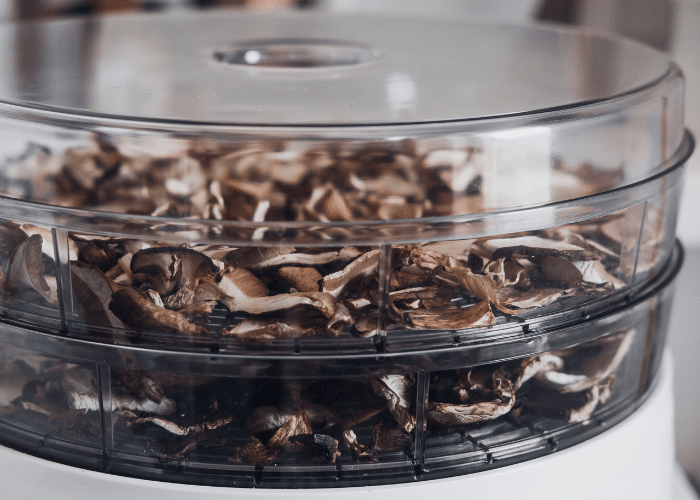
To dehydrate maitake mushrooms, clean and slice them into thin pieces and place them on a dehydrator tray or baking sheet. Dry them at a low temperature until they are crispy and brittle. Store the dried mushrooms in an airtight container in a cool, dry place for up to 6 months.
5. Pickling
To pickle maitake mushrooms, clean and slice them, then simmer in a mixture of vinegar, sugar, salt, and spices until tender. Transfer the mushrooms and pickling liquid to a jar and store in the refrigerator for up to 1 month.
6. Canning
For long-term preservation, canning is a great option. Clean and slice the mushrooms, then pack them into jars with boiling water and salt. Follow the instructions for your canner to process the jars and seal them. Canned maitake mushrooms can last for up to a year.
Helpful tips:
- Avoid washing the mushrooms before storing or freezing them to prevent excess moisture that may cause spoilage.
- Remove any brown spots or signs of decay on the mushrooms before storing or using them.
- For the best flavor and nutrition, use the mushrooms as soon as possible after purchasing or harvesting.
- Ensure proper canning procedures are followed to prevent botulism.
- Experiment with different spices and flavors when pickling maitake mushrooms.
- Use clean and sterilized jars and equipment when canning or pickling to avoid contamination.
Maitake Mushroom Recipes
If you’re looking for some delicious maitake mushroom recipes to try, we’ve got you covered! Two of our favorites you should try:
Farro Salad with Roasted Maitake and Butternut Squash
If you’re looking for a healthy and flavorful dish to enjoy in the fall, this recipe for Maitake Mushroom and Farro Salad with Roasted Butternut Squash is a great option. It combines roasted vegetables with fresh herbs and farro to create a filling and nutritious meal that’s easy to make.
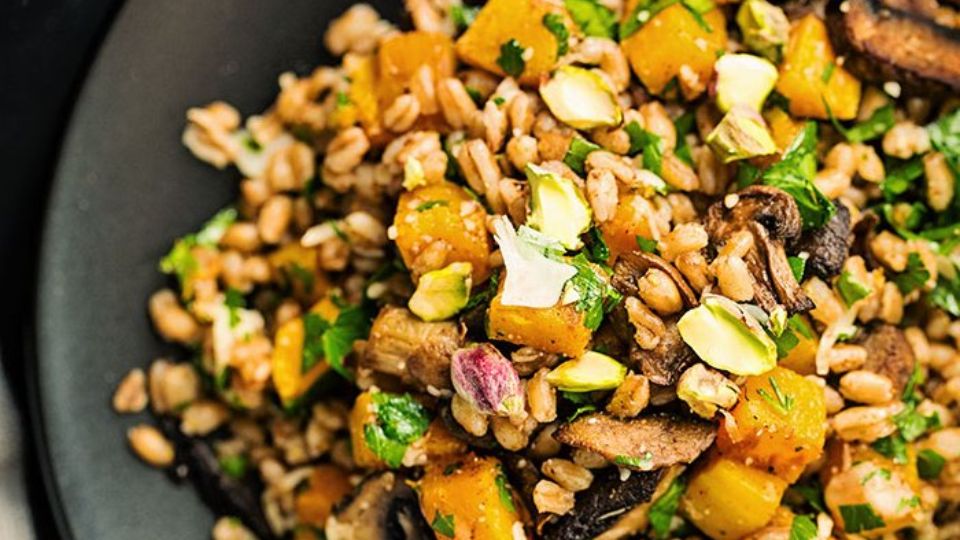
Difficulty: Easy Preparation Time: 10 minutes Cook time: 25 minutes Servings: 4
Ingredients
Instructions
- Preheat oven to 400°F (204°C).
- Toss the sliced maitake mushrooms and diced butternut squash with 2 tbsp of olive oil and season with salt and pepper.
- Spread the mushrooms and squash on a baking sheet and roast for 20-25 minutes, or until golden brown.
- In a large bowl, mix together the cooked farro, roasted mushrooms and squash, chopped parsley, thyme, remaining olive oil, and balsamic vinegar.
- Season with salt and pepper to taste and serve.
NOTE
- For a more filling meal, consider adding some protein such as grilled chicken, shrimp or tofu.
- To save time, you can roast the vegetables and cook the farro ahead of time and then assemble the salad just before serving.
- Don’t overcrowd the baking sheet when roasting the vegetables, as this can prevent them from browning properly.
- Feel free to adjust the seasoning and vinegar to taste.
- Leftovers can be stored in an airtight container in the fridge for up to 3 days.
Japanese Style Ramen With Maitake Mushrooms
If you’re looking for a tasty and simple meal to try, have you considered making maitake mushroom ramen? This dish brings together tender mushrooms, savory noodles, flavorful broth, and crunchy nori, all topped off with a soft-boiled egg. It’s the perfect comfort food for any season and is sure to satisfy your cravings.
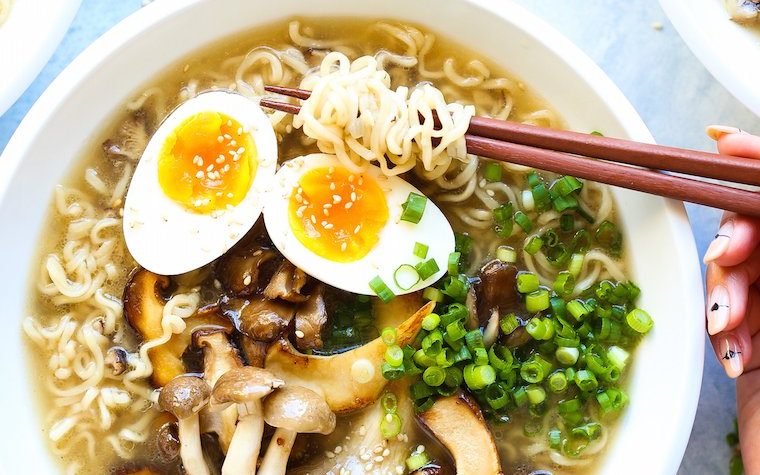
Difficulty: Easy Preparation Time: 10 minutes Cook time: 20 minutes Servings: 4
Ingredients
Instructions
- In a large pot, bring the broth to a boil.
- Add the sliced maitake mushrooms, soy sauce, miso paste, and sesame oil to the pot.
- Simmer for 10-15 minutes, or until the mushrooms are tender.
- While the broth is simmering, cook the ramen noodles according to package instructions and drain.
- In a separate pot, bring water to a boil and add the eggs. Boil for 7 minutes, then remove from heat and place in an ice bath. Peel the eggs and cut them in half.
- To serve, divide the cooked ramen noodles among four bowls.
- Pour the broth and mushroom mixture over the noodles and top with the halved eggs, sliced scallions, and nori pieces.
- Season with salt and pepper to taste and serve hot.
What Are Maitake Mushrooms?
Have you heard of “Hen of the Woods“? It’s a type of mushroom commonly referred to as the maitake mushroom (Grifola frondosa), and is also known as “Sheepshead.” It’s a popular type of edible mushroom that grows in clusters at the base of trees, especially oak trees.
Maitake boasts a long-standing history in traditional Chinese and Japanese medicine due to their health benefits. These mushrooms possess a distinctive fan-like shape, with a brownish-gray hue, and a rich savory, earthy flavor with a meaty texture, and they are a popular ingredient in a variety of cuisines worldwide.
Cooking them is a breeze, and they can be prepared using various methods like sautéing, grilling, or roasting, among others. So, they make a fantastic addition to any dish. Moreover, their high nutrient content makes them a valuable addition to any diet.
Where Do Maitake Mushrooms Grow?
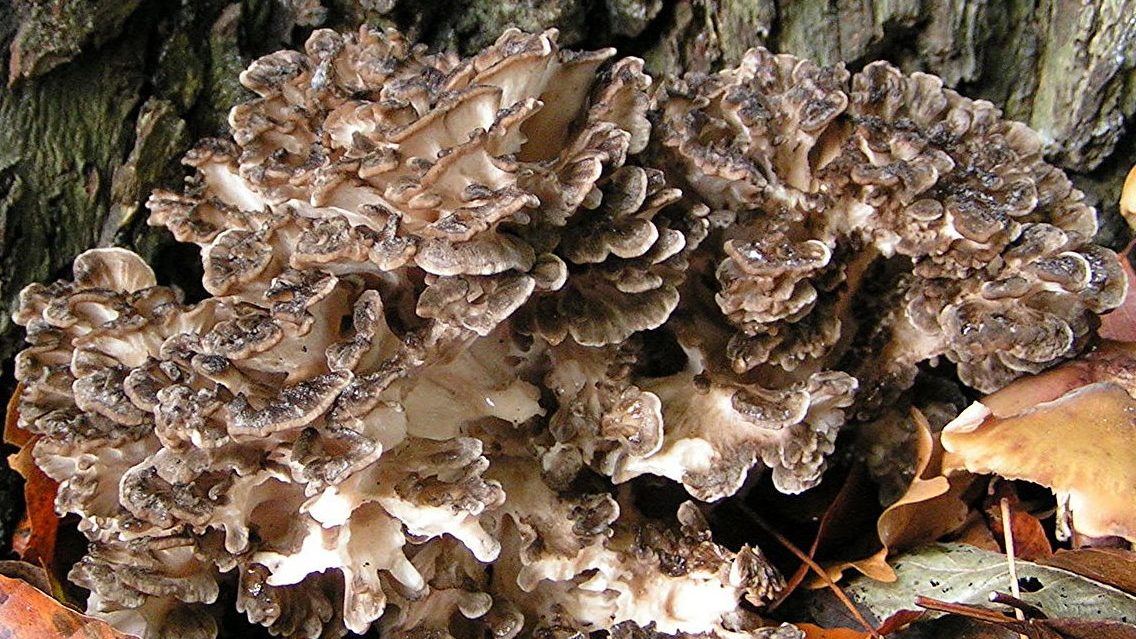
These mushrooms are abundant during the fall season, making it the perfect time to go foraging. If you’re interested in finding these tasty fungi, you’ll want to explore the base of deciduous trees, especially oak. Additionally, other hardwood trees like maple and elm may also yield a plentiful harvest of maitake mushrooms.
To maximize your chances of finding them, keep an eye out for clusters of the mushroom. These mushrooms can be found in temperate regions around the world, including North America, Europe, and Asia.
Identify Maitake Mushrooms
It’s easy to recognize maitake mushrooms due to their unique look. They resemble a hen’s feathers, aptly earning them the name “Hen of the Woods.”
The fronds are grayish-brown, with a wavy, layered appearance and typically measure between 10-50cm in diameter, though they can grow much larger in ideal conditions.
To identify Maitake mushrooms, there are a few key characteristics to look for. Firstly, they have a unique fan-like shape with multiple overlapping layers of caps, resembling the ruffled feathers of a hen. The caps are typically brownish-gray with a wavy, layered appearance and typically measure between 10-50cm in diameter, though they can grow much larger in ideal conditions, and have a distinct texture that is both meaty and tender.
Another identifying feature is the mushroom’s stem, which is thick and often has a white color. Maitake mushrooms also have a distinct, earthy aroma that can help with identification.
Luckily, there are no poisonous lookalikes to maitake, so foragers can feel safe. Edible fungi closest in appearance include Berkeley’s polypore, cauliflower, and black stain mushrooms.
Maitake Mushrooms Health Benefits
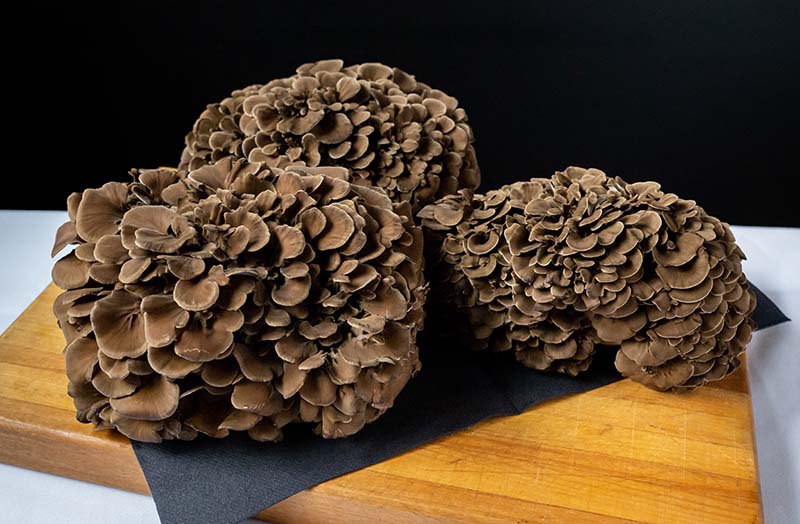
5 Amazing Benefits
1. Boosting Immune System
Maitake mushrooms are an excellent source of beta-glucans, which can boost your immune system. These beta-glucans work by activating your immune cells, making them more effective in fighting infections and diseases.
2. Reducing Cholesterol
They are a great source of polysaccharides, which can help reduce cholesterol. Research has shown that consuming maitake mushrooms can help lower LDL (bad) cholesterol levels and boost HDL (good) cholesterol levels. Eating maitake mushrooms can be beneficial to your cholesterol levels.
3. Fighting Cancer
These mushrooms may have anti-cancer properties due to their beta-D-glucan polysaccharide. Research indicates that this compound can strengthen the immune system and decrease the growth of cancer cells[1].
4. Anti-aging Benefits
They are packed with powerful antioxidants, like beta-glucans, that help protect the body from free radicals. These molecules can cause cell damage and premature aging if left unchecked. Beta-glucans in Maitake mushrooms work to neutralize free radicals, giving your skin a fighting chance against wrinkles[2].
5. Help Digestions
They are loaded with fiber, a nutrient essential for healthy digestion. Consuming fiber can help keep your bowel movements regular, prevent constipation, and reduce your risk of colon cancer.
Maitake Nutrition Facts
Here’s a table for the nutrition facts of Maitake mushrooms per 100 grams (3.5 ounces) of edible portion:
| Nutrient | Amount per 100g |
| Calories | 31 kcal |
| Protein | 2.2 g |
| Fat | 0.4 g |
| Carbohydrates | 6.9 g |
| Fiber | 2.7 g |
| Sodium | 2 mg |
| Zinc | 0.3 mg |
| Iron | 0.3 mg |
| Vitamin C | 2.5 mg |
| Vitamin K | 5.3 mcg |
| Selenium | 9.7 mcg |
| Magnesium | 16 mg |
| Phosphorus | 45 mg |
FAQs
Do Maitake Mushrooms Need to be Washed?
Yes, it’s a good practice to wash Maitake mushrooms before using them in cooking. Gently rinse them under cold running water to remove any dirt or debris. Pat them dry with a paper towel or cloth before preparation to ensure a clean and safe culinary experience.
What Part of Maitake Mushrooms Do You Eat?
You can eat the entire Maitake mushroom, including the caps and stems. They have a meaty texture and a rich, umami flavor. However, some recipes may suggest removing the tough stem base for certain dishes. Use Maitake in stir-fries, soups, or sautés for a delicious culinary experience.
Can you Eat the Stems of Maitake Mushrooms?
Yes, you can eat the stems of maitake mushrooms. They are edible and can be cooked in a variety of ways to enhance the flavor of your meal. The stems are also rich in nutrients and vitamins, making them a healthy addition to your diet. When preparing maitake mushrooms, be sure to clean them thoroughly before consuming them.
Do Maitake Mushrooms Taste Good?
Yes, Maitake mushrooms are known for their delicious taste. They have a rich, earthy flavor with a hint of umami, making them a popular choice in various culinary dishes. Many people enjoy their meaty texture and robust taste, making Maitake a delightful addition to a wide range of recipes.
How to Cook Hen of the Woods (Maitake)?
To cook Hen of the Woods (Maitake) mushrooms, clean and separate them into bite-sized pieces. Sauté in oil or butter over medium-high heat until golden brown (about 5-7 minutes). Season with salt, pepper, and optional herbs or garlic. Serve as a side dish, in pasta, or as a topping for meats.
How Long Does it Take to Roast Maitake Mushrooms at 425?
Roasting maitake mushrooms in an oven preheated to 425°F typically takes about 20 minutes. To ensure the mushrooms are cooked through, use a thermometer to check the internal temperature. If the internal temperature is 160°F, the mushrooms are ready.
Can you Eat Maitake Mushrooms Raw?
While it’s safe to eat small amounts of Maitake mushrooms raw, they are typically cooked before consumption. Cooking not only enhances their flavor but also makes them easier to digest. Most people prefer the rich, umami taste and meaty texture of cooked Maitake over raw.
Summary
Explore this comprehensive guide for valuable insights on cooking Maitake mushrooms, featuring two fantastic recipes for you to try. It provides information on identifying fresh mushrooms, their nutritional advantages, and potential side effects. You’ll also discover preparation techniques and receive cooking time tips. This resource is an excellent choice for anyone eager to savor the delicious versatility of Maitake in various dishes.
References
1. A phase I/II trial of a polysaccharide extract from Grifola frondosa (Maitake mushroom) in breast cancer patients: immunological effects https://www.ncbi.nlm.nih.gov/pmc/articles/PMC3751581/
2. Anti-Aging and Neuroprotective Properties of Grifola frondosa and Hericium erinaceus Extracts https://www.researchgate.net/publication/364434727_Anti-Aging_and_Neuroprotective_Properties_of_Grifola_frondosa_and_Hericium_erinaceus_Extracts

